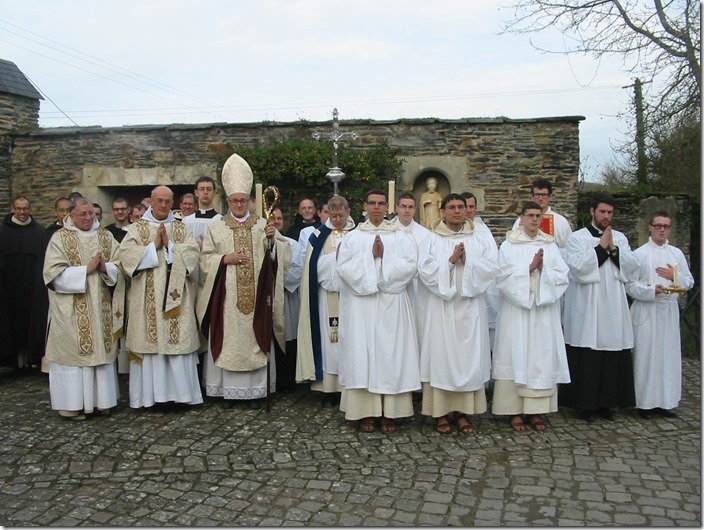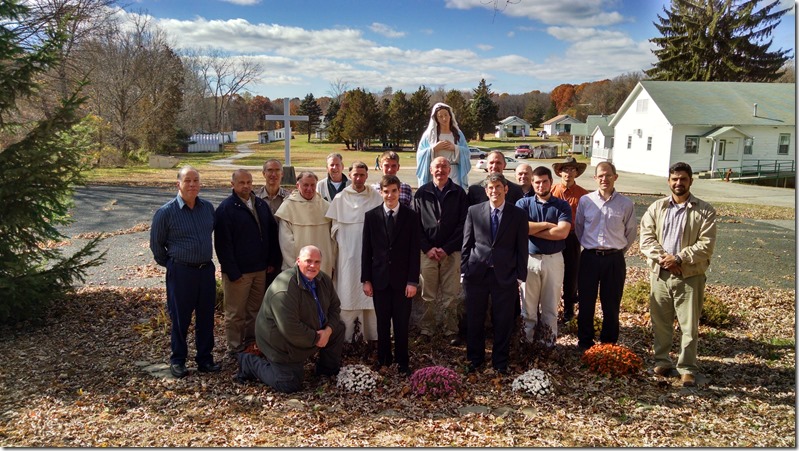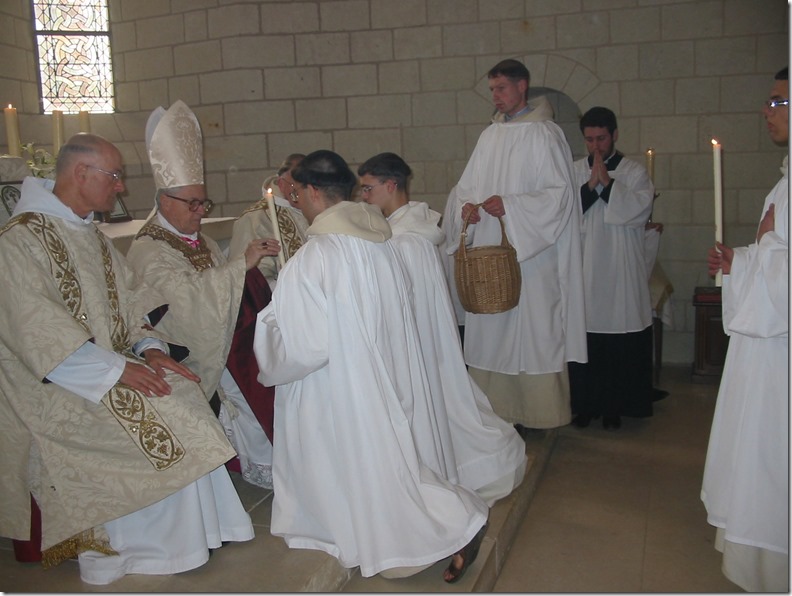Open Letter to the Faithful of Quebec and the Maritime Provinces
by Fr Pierre ROY(SSPX)
Lakeville, June 3rd, 2016
Feast of the Sacred Heart of Jesus
« The night is far advanced; the day is at hand. Let us therefore lay aside the works of darkness, and put on the armor of light. Let us walk becomingly as in the day. » Roman, 13; 12-13
Dear brethren,
This letter is to notify you of my decision to leave the Society of St. Pius X. In spite of my sermon on April 17th last, many of you will be surprised to learn of my departure. I hope then that these lines will show more clearly the reasons why I am leaving.
I would like to say first that I did not wish that my sermon of April 17th be published urbi et orbi and that I myself did all I could to prevent its diffusion. I was preaching merely for the chapel of Montreal, that portion of the Lord’s flock entrusted to me by my superior. With that said, the Lord has willed that it be otherwise. Blessed be his Holy Name!
I was born and raised in the arms of the Society. I owe everything to the work of Archbishop Lefebvre. This is why I am well aware of the gravity of the action I take before God and before yourselves, and aware also of the duty one day to account for myself before the Tribunal of the Just Judge.
For several years already the authorities of the Society – they no longer cloak themselves – have been organizing a reunification with Apostate Rome. Is it legitimate to place oneself under authorities who do not have our Faith, or to accept from them a recognition, so long as they demand “no compromise”?1 I leave you to judge of it with these words of Pope Pius XI :
“Everyone knows that John himself, the Apostle of love, who seems to reveal in his Gospel the secrets of the Sacred Heart of Jesus, and who never ceased to impress on the memories of his followers the new commandment ‘Love one another,’ altogether forbade any intercourse with those who professed a mutilated and corrupt version of Christ’s teaching: ‘If any man come to you and bring not this doctrine, receive him not into the house nor say to him : God speed you.’ For which reason, since charity is based on a complete and sincere faith, the disciples of Christ must be united principally by the bond of one faith. Who then can conceive a Christian Federation, the members of which retain each his own opinions and private judgment, even in matters which concern the object of faith, even though they be repugnant to the opinions of the rest? And in what manner, We ask, can men who follow contrary opinions, belong to one and the same Federation of the faithful?” (Encyclical Mortalium Animos against oecumenism)
You also know, dearest faithful, that the Society has always called it illegitimate to align oneself with those who have removed themselves from Tradition and no longer profess the Faith in its integrity. Why, after all, have we permitted ourselves these last 30 years to criticize the Fraternity of Saint Peter? Why have we more recently criticized Campos? Why did we repudiate the agreement reached in 2006 by the Institute of the Good Shepherd?
Having recently asserted to a superior that it will be necessary for us to cease criticizing these communities, I received the following response: “Ah, but we will continue to criticize them!” I then asked why, by what principle. I received no further reply.
No, either we have been wrong since 1988 and even since 1975, or we have been wrong since 2012. Unless we too adopt a subjective conception of the truth, and what was true in 1988 is no longer. A last solution – by means of which seemingly anything can be justified : the situation has changed. We are witness, says our superior general, to a turning point in the history of the Church : they no longer want to impose the Council upon us; Pope Francis “appears to be someone who would like to see the whole world saved, that everyone have access to God,”2 he continues. Did Jesus not say, “If you love me, keep my commandments”? (John 14:15) One may seriously ask himself if Pope Francis, who practically denies the commandments before the whole world, truly seeks to save souls. On the other hand, did Archbishop Lefebvre not write in his Spiritual Journey, his testament to his priests, “It is the strict duty of every priest and layman wishing to remain Catholic to separate himself clearly from the Conciliar Church, for so long as she does not profess the tradition of the Church’s Magisterium and of the Catholic Faith,”3 as we were reminded by Bishop Tissier de Mallerais not so long ago?
Some will say, “It is not yet done. Wait until it is done!” This is what I myself said to many among you, my dear faithful, for some years, hoping and believing sincerely that the authorities of our Society would turn back. But I must face the evidence that they have not. Day after day, declaration after declaration, they continue to inoculate into the souls of faithful and priest alike a pernicious error, which holds it legitimate to seek from the Conciliar authority a recognition and jurisdiction that is made exceedingly dubious by this authority’s daily betrayal of the Faith. This error, which insinuates itself in the spirits of each, causes even priests known for their doctrinal intransigence (this being a virtue) to become less and less combative to the point where they will soon be ready to betray everything.
This is accomplished in a gradual way and without us realizing the ambiguities introduced. It began by convincing us that a Motu Proprio which puts the Sacrifice of Our Lord Jesus Christ on an equal footing with, and even subordinate to, what Archbishop Lefebvre very justly called the “mass of Luther,” was welcome and beneficial. We thanked the conciliar authorities for this gesture, though timidly maintaining that solely the mass of St. Pius V is legitimate. It was a first step, or perhaps a first misstep. They say to us, “Does the Motu Proprio not produce marvellous results?” But since when have practical results been more important than the purity of the doctrine of Christ? Since when has truth profited from human compromise? “Do not do evil that there may come good,” the Apostle told us. (Romans 3:8)
Next they convinced us it was acceptable to sing a solemn Te Deum for the publication of a document which, in lifting the “excommunications” of the four bishops consecrated by Archbishop Lefebvre, restated in principle that our bishops had been well and truly excommunicated. This decree lifting the false sentence brought against our bishops is ultimately nothing but a fresh condemnation of the actions of Archbishop Lefebvre, whom we have still the insolence to call “our revered founder.”
Not putting in practice the advice of St. John nor that of Our Lord Jesus Christ (“Beware of false prophets,” Matthew 7:15), in discussion after discussion, and meeting after meeting, we eventually silence our suspicions, which are more than legitimate and healthy in the face of persons who deny the Kingship of Our Lord Jesus Christ. This is how our superior has become, according to Pope Francis, a man “with whom one can dialogue,” with whom he who currently directs the subversion and the destruction of the Church of Our Lord Jesus Christ believes he can do “good work.4“ Is there any wonder then that they happily grant us jurisdiction for confessions (which was never lacking)? How can we claim that we are asking for nothing, but that Rome gives everything? Have we not just recently asked for the doubtful jurisdiction of conciliar Rome with respect to the other sacraments? No, truly, we ask for nothing! Rome, who scourges Our Lord Jesus Christ, wishes us well! This is rather worrying: which side are we on?
The new direction of our Society is imposed on priests, on many priests who have never desired it. Enforced silences, transfers, promotions, trials, threats, promises, exclusions, all become justifiable when they work do defend the “position of the Society,” which is in fact – as always in a revolution – the position of a minority which has taken power and which deftly manipulates the passive majority. Following my sermon of April 17th, besides the desperate reactions of certain colleagues, they ordered me to be silent. They wished me to swear on my priesthood (!) to speak no more from the pulpit on the question of an accord with apostate Rome. “You have many other subjects on which you can speak,” they told me. Naturally I am conscious that the principal subject of preaching is not the joining of our Society to Rome, but the Gospel of Our Lord Jesus Christ. But I would note – you are my witnesses, dear brothers – that that was the first time in five years of ministry that I had spoken on this question from the pulpit. I refused to be silenced. However, I promised to warn my superiors before treating the subject from the pulpit again. “If you intend to speak of it again,” they told me, ‘You will have the right to confess and to say mass, but you cannot preach. Otherwise, leave the Society and say what you wish.” That is what I am doing, brethren, because a priest must preach and alert his flock to the wolves who threaten to devour them.
I have no absolute certainty that the Society will join itself to Rome. Nevertheless I have moral certainty that they will do so, given the clear, express, and reiterated will of both Rome and the Society to arrive at an arrangement, and given also the absorption these last months of the last episcopal voices which firmly opposed it. That God preserve us from this tragedy – this will, in spite of my departure, continue to be my fervent prayer!
In the meanwhile, having on the day of my baptism renounced not only Satan and his works, but also his seductions, I cannot accept that my immortal soul be sold to the conciliar sect, nor accept even that it be put up for sale. Consequently, the fact that the superiors of the Society have shown on numerous occasions their amenability to a practical accord (in the absence of Rome’s conversion) suffices for me to take this step, prudently, not before having prayed at length and taken counsel with wise priests. There is no question for me whatsoever of remaining silent about what is being done. I have kept silence too long, hoping and assuring you, brethren, that the Society superiors would eventually open their eyes. But the more time passed, the more was I forced to accept the evidence that those who lead us do not intend to turn back.
I must confess that to speak openly of the treachery we are living through is a very delicate business if one remains within the Society. Which is why I am leaving: for the ability to preach the truth in its integrity, since I must someday answer for each of the souls entrusted to me. To keep silent was no longer possible without making myself guilty before God.
In the past I have severely criticized those we call the “Resistance,” but whom others call the “Subversion,” and still others, “Fidelity.” I must say that besides the fact that I did not at that time see things as clearly as (by the grace of God) I now do, I was reacting mainly to the misbehavior of certain colleagues who visited our province and who, though clear-sighted, were rather cavalier, much to the discredit of the courageous stance taken by those who refused the betrayal imposed on us. I will try with God’s grace to avoid the attitudes I have denounced and to devote my energy to rebuilding rather than to badgering those who wish to place us in Rome’s hands. With that said, to denounce errors and deceptions remains a necessary duty which with God’s aid I will fulfill.
Many clear-sighted priests do not dare for now to act against the imposition. I believe the principal reason restraining them is the fear of breaking the unity of the institutions that have with such difficulty been built up. How accept that in dividing the faithful, we risk contributing to the closure of a chapel? The reply is that faithful priests are not the origin of the division brewing in our ranks, but the very authorities of the Society, who would have us believe that we are participating in a turning point in the situation of the Church, when in fact it is not the situation that has changed, but only their minds. Dear brothers, if the directors of the Society continue to sow distrust and confusion by their mistaken ideas, the division will swell, and it may become necessary to burst it open in our region for the common good.
For my part, I would that the Lord spare me from having prematurely to break the unity of the few chapels we have in French Canada. This is why I have decided to remain for the moment in the Maritimes. The faithful in these parts lack frequent access to the true Mass and the true Sacraments. They are mostly without spiritual help. They raise their children without the support of the Church. Therefore I thought it best to keep to this region and concentrate my efforts on developing these small groups that have so little access to the sacraments, hoping one day to return these communities to the hands of the Society, only made larger and more fervent by the grace of God and by my ministry. For this is my greatest hope: that the Society turns back in a clear and unequivocal manner, that I may return these missions to it, and that I may myself re-enter its ranks, profiting anew from the priestly fellowship offered there. I cling to no illusions, but miracles are always possible…
However, it remains clear that the more the situation deteriorates, the more it will become necessary to tend to souls in Quebec who feel betrayed and deceived. My hope is that more priests arise and come carrying the truth to those who desire it for themselves and their children. Because while it is obvious that the Society continues to disburse the help of the sacraments – of which it would be illegitimate to deprive oneself without very grave reason – it is no small thing in this crisis of the Church to have access to sound preaching and to continue to see clearly through the painful events we are experiencing.
Begging you pray for me, I also assure you, dear brethren, of my prayers at the altar and of my blessing.
“Serve ye the Lord with gladness!” Ps. 99
Father Pierre Roy
Mission Notre-Dame-de-Joie
1974 Route 134
Lakeville, E1H 1A6
New Brunswick







